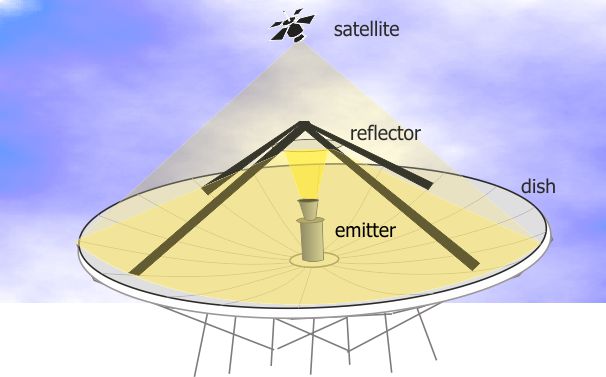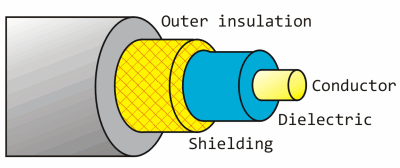Freesat reception - all about dishes
 Brian Butterworth published on UK Free TV
Brian Butterworth published on UK Free TV Satellite reception has both advantages and disadvantages compare with terrestrial (aerial) reception.
By using much higher frequencies (gigahertz, compared to terrestrial televisions megahertz) more transmission channels called transponders (the satellite equivalent of multiplexes) can be provided. For example, there are only six Freeview multiplexes, but Sky or Freesat users can access two hundred satellite transponders.
Aside from exceptional weather conditions (very heavy rain for example) digital satellite provides stable pictures and audio. Where Freeview transmitters are no more than 732 metres above sea level, the geostationary satellites used for television are 35,800,000 metres above the equator so reception is possible even where buildings, trees and hills make terrestrial reception impossible.

The downside of the transmitters being 22,300 miles up in the air is that the signals are very, very weak - so standard TV aerial is of little use. When the signals are sent to the satellites, huge dish transmitters are used to uplink the signal to the satellite. These are tens of metres from side to side, and feature an emitter that generates the signal, which is first bounced of a mirror (called a reflector) and then off the surface of the parabolic dish.

There are many satellites in the sky over the equator. Often these are in clusters over a particular position, for example there are four used for UK television are at 28.2 degrees east. There is another cluster over the 19.2 degrees east positions that are used for German television.
To receive these very weak signals from the satellite, it is necessary to use a dish for reception too. By using a reflective dish, this concentrates the signals onto a small device called a LNB. This is held in front of the dish by a metal arm.

The size of dish for reception is typically much smaller; often 60cm to 100cm in diameter, but the exact size depends upon the transmitting satellite transponder. To keep the transmission power levels down to levels that can be powered by the satellite's solar panels, each beam is focused on a particular area of the Earth's surface. If you are trying to receive the signal at the centre of this zone, a small dish is required. At the outer edges, you may need a 5 metre dish. Maps of these zones are provided by the satellite companies, and are called satellite footprints.
When the dish is installed it must be aligned carefully as the signal is very weak. The installer needs to know the inclination and the azimuth from the ground location to the satellite. If you install yourself you will find that there are markings on the dish that are used to point the dish in the correct position. It is important that the view of the satellite will not be blocked, so must take into account leaves growing on trees and potential building works.
For many people the LNB will have a single cable connected to it, however if you have Sky+ or a multi-room installation the LNB package will actually contain four receivers a quad-LNB. Unlike terrestrial television where you can split the aerial cable to feed more than one Freeview box or television set, with satelite reception you cannot. So, a Sky+ box with two receivers (so you can watch one thing and record another) has two cables connecting the box to the dish.
The cable that connects the dish to the receiver must be satellite grade cable. Whilst this looks superficially like the cable used to connect and aerial to a television, a higher grade cable is required for satellite reception.
Here is an image of a co-axial cable. This sort of cable is used to connect any type of receiving aerial to the reception equipment.

RG6, PF100 and PH100 are all types of coax cable that are suitable for the very weak signals that are received by a satellite dish. (The power is the same as you would receive from a one-bar electric heater on the moon).
The conductor in the centre passes the signals received from the dish to the set-top box. This is made from steel in RG6 cable, and from copper in the RF100 and PH100 types. This makes RG6 less suitable in the UK where rain can damage the cable.
The shielding is responsible for keeping unwanted external interference from damaging the signal. In the cheaper cable this will be a foil wrap, in better specified cables this is a braid (or mesh) of copper wires. The sheild in the RF100 covers 58% of the cable.
The non-conducting layer between the shield and the conductor is called the dielectric. This can be either a solid (RG6), foam (RF100) or air-spaced (PH100) dielectric. This makes the cables progressively more flexible (ie bendy without damage).
Peter: Yes, that could certainly be the case, or possibly there is something coming between the dish and the satellite (depending on where you have mounted it).
| link to this comment |
9:53 PM
Trouble with sagemcom dtr 94320 freesat recorder not responding to record button on remote either directly or via epg green button on display blinks all other functions seem ok including reception. I have just read a review of recording facility freezing on same model and sagemcom has told them it must be their LNBs is this possible or is it internals in box?
| link to this comment |
Dennis the Menace: You might like to try, with the power off, swapping over the two satellite inputs.
| link to this comment |
9:08 PM
I've got a Panasonic viera freesat I know I have to run cable from sky dish bit all I have on the back of tv is a normal aerial connection which I'd use to plug in a normal aerial. All I can think is to connect a normal aerial connecter to plug into tv & connect other end into sky dish, is this right? if not can anyone help please
| link to this comment |
lucilou: No, you can't connect your dish to a "normal aerial connection", only to the satellite connection.
If you have a Freesat TV then there will be a satellite input connector on the back.
| link to this comment |
3:40 PM
Just got myself a Humax Freesat as I'm fed up with sky! The signal strength on the Humax shows only about 50%... I use to get pixilation on most sky channels so I was wondering... would it help if I fitted a decent LNB. Any comments would be welcome
Thanks
| link to this comment |
Alan: It is more likely that your dish is not 100% aligned with the satellite, you should check that first as a new LNB won't help if the alignment is off.
| link to this comment |
3:57 PM
Mountain Ash
Thanks for the prompt reply!
I'll get myself a meter and check the dish, I will leave feedback when it's done.
Thank you.
| link to this comment |
Alan's: mapA's Freeview map terrainA's terrain plot wavesA's frequency data A's Freeview Detailed Coverage
4:32 PM
Dennis the menace back online sorry for not replying sooner sagemcom 94320 recording functions freezing and not responding to handset. Tryed your little tip and it seemed to work ok first few tries then froze again message came up hard drive having trouble so fomat the hard disk this i did which did not seem to solve it fully i have since found out if i turn power off for a few seconds and back on again that works for so long any ideas?
| link to this comment |
8:51 PM
I have a Panasonic TV with Freesat. All of a sudden the HD channels (BBC) show as 'no signal' but all the rest are still ok.
Any ideas?
Thanks!
| link to this comment |